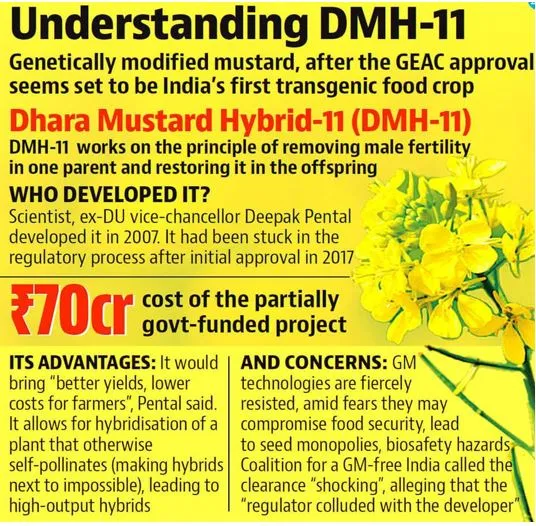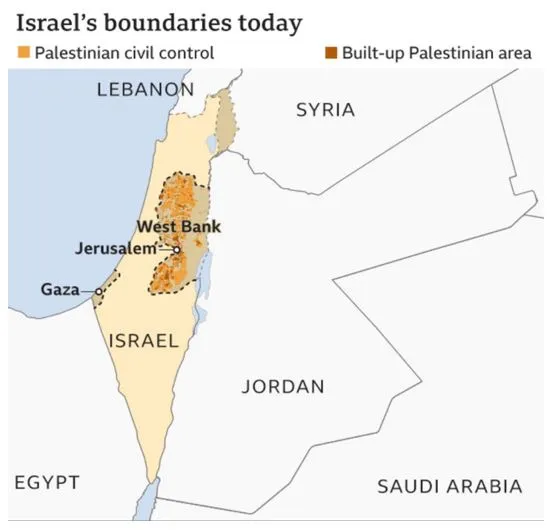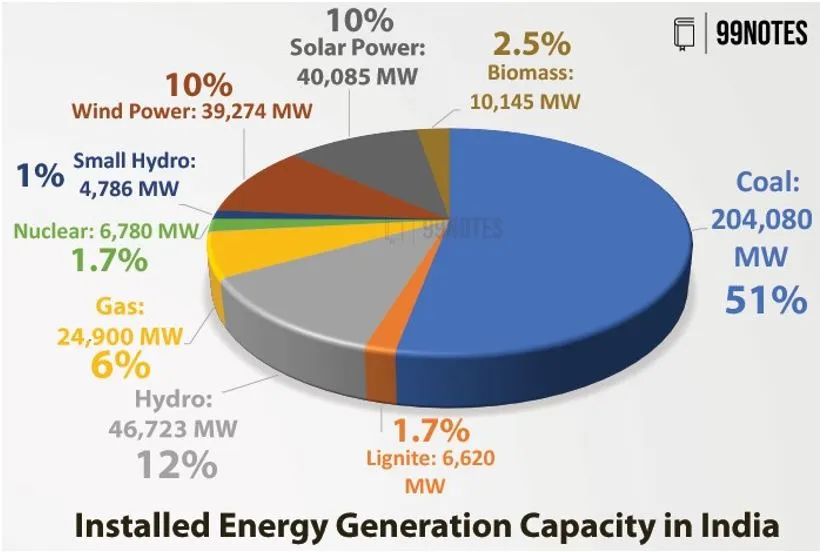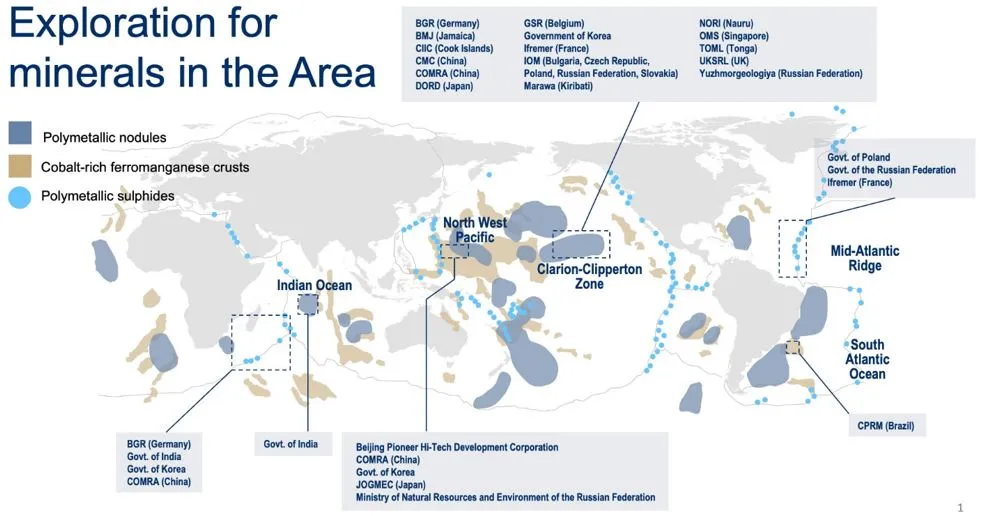

5th August 2024 (9 Topics)
Mains Issues
Supreme Court of India has recently delivered a split verdict on the question of allowing genetically modified (GM) mustard in farmer fields.
What are Genetically Modified Crops (GM Crops)?
- Genetically modified (GM) crops are plants used in agriculture, the DNA of which has been modified using genetic engineering techniques.
- In most cases, the aim is to introduce a new trait to the plant that does not occur naturally in the species like resistance to certain pests, diseases, environmental conditions, herbicides, etc.
- Genetic modification is also done to increase the nutritional value, and production of pharmaceuticals, biofuels etc.
- GM crops are also referred as genetically engineered (GE) plants, transgenic crops, living modified organisms (LMOs), or biotech crops.
About GM Crops and Prospects:
- Historical Background: GM crops first introduced in USA in the mid-1990s, are presently widely cultivated and used globally.
- GM crops currently grown are engineered mainly for insect resistance or herbicide tolerance. A total of 16 GM crops are cultivated in various countries out of which corn, soybean, cotton and canola are the four largest acreage.
- Some Major GM Crops in India:
- In India, Bt cotton is the only GM crop approved for cultivation.
- It is grown on approx. 11 million hectares.
- Bt cotton, first grown in 2002 now occupies more than 90% of cotton area in the country.
- Several more crops such as chickpea, pigeonpea, corn, sugarcane, etc. are in various stages of research and field trials.
GM Mustard Debate:
What is GM Mustard?
|

What are challenges related to GM Crops in India?
- The impact of growing GMO crops like GM mustard on the health of the population, the environment (the soil on which it is grown), the food chain, the groundwater, etc., is still unknown.
- GMOs carry risks of ‘unintended’ effects and toxicity due to changes made at genetic level which would be irreversible
- Weeds are wild plants that soak up nutrients from the soil and do not allow crops to absorb the nutrients.
- GMOs can pose significant allergy risks. Genetic enhancements often combine proteins not contained in the original organism, which can cause allergic reactions for humans.
- GMOs also carry risk of affecting the biodiversity by compromising the gene pool of wild varieties of crops.
- GMOs also carry a financial burden for producers as seeds have to be bought new from the GM crop companies for every crop.
- They also carry ethical concerns like violation of natural organisms’ intrinsic values, and tampering with nature by mixing genes among species.


Mains Issues
Recently, Israel carried out a massive air strike on Hodeidah, the Red Sea port city in Yemen, that is controlled by the Houthi militia, in response to a drone attack by the Houthis that had hit Tel Aviv. The attack reportedly caused losses worth millions, besides killing at least three and wounding over 80 others.
What is the issue?
- The conflict between Israel and Iran has created a situation of turmoil affecting the security of the large Indian diaspora based in the Gulf region.
- Iran has launched significant attacks on Israel, deploying over 300 projectiles, including drones, cruise missiles, and ballistic missiles. This action was widely seen as retaliation for a deadly strike on Iran's consulate in Damascus, Syria.
- This has created the additional risk of piracy and hostage-taking in the Gulf region.
Reasons for Israel-Iran Conflict:
- Historical Context: Iran and Israel have had a tumultuous relationship since the Iranian Revolution of 1979, which transformed Iran from a close ally of Israel under the rule of the Shah to an Islamic Republic openly hostile towards Israel.
- Religious and Ideological Differences: Iran is an Islamic republic governed by Shia Islam, while Israel is a predominantly Jewish state.
- The religious and ideological differences between the two countries have contributed to mutual suspicion and animosity.
- Israeli-Palestinian Conflict: Iran has been a staunch supporter of Palestinian causes, including backing militant groups like Hamas and Hezbollah, which are considered terrorist organisations by Israel.
- Iran's support for these groups and its calls for the destruction of Israel have heightened tensions.
- Geopolitical Rivalry: Iran and Israel are regional rivals vying for influence in the Middle East. They have conflicting interests in various regional conflicts, including the civil wars in Syria and Yemen.
- Where Iran supports the Assad regime and Houthi rebels, respectively, while Israel opposes Iranian influence in these countries.

Impact on India:
- Conflict between Israel and oil-rich Iran could disrupt oil supply from the region, leading to a rise in oil prices globally.
- India imports around 2 million barrels of crude oil daily through the strategic Strait of Hormuz located at the mouth of the Persian Gulf. Any conflict or instability in the region would lead to supply shortages and increasing energy costs leading to inflation and constraining Economic Growth in India.
- The strategic connectivity interests of India might be affected. This includes the port of Chabahar in Iran, linking India to Afghanistan and Central Asia.
- Shipping disruption in the Red Sea would affect the trade in the region.
- A disturbance here could lead to delays, increased shipping costs, and instability in global trade.


Mains Issues
Context
Amid concerns raised against mining metals and rare earths from ocean deep floor which can permanently damage fragile marine systems. The International Seabed Authority, or ISA, is working on a set of rules to regulate the extraction of raw materials from the ocean floor.
What is Deep-sea Mining?
- Deep-sea mining is the process of retrieving mineral deposits from the deep seabed – the ocean below 200m.
- Depleting terrestrial deposits and rising demand for metals mean deep-sea mining may begin soon, even though research suggests that it could destroy habitats and wipe out species.
- Deep-sea mining should be halted until the criteria specified by the IUCN are met, including the introduction of assessments, effective regulation, and mitigation strategies.
The present state of deep-sea mining:
- By 2025, the ISA wants to define a set of legally binding rules to manage deep-sea mining — without these rules, any planned mining operation will not be able to get started.
- Discussions have been ongoing for several years, but these latest talks have laid bare the extent to which the new rules remain divisive, especially when it comes to the issues of underwater monitoring and avoiding environmental damage.
- Several states, including Germany, Brazil, and the Pacific Island nation of Palau, have said they won’t agree on the new rules until their environmental impact has been fully investigated.
- China, together with Norway, Japan, and Nauru in the Central Pacific have made mining companies to start putting their plans into action.
Concerns related to Deep-sea Mining:
- Deep-sea mining focuses on extracting manganese nodules and other minerals from the ocean floor in international waters, known as the high seas, which cover over half of the world's oceans.
- These resources are considered the "common heritage of mankind," meaning they belong to everyone and are managed by the International Seabed Authority (ISA) under the United Nations Convention on the Law of the Sea.
- The UN's sea convention mandates that activities in the high seas, including profits from deep-sea mining, must be equitably shared among states. However, groupings like the Deep-Sea Conservation Coalition are skeptical about the feasibility of ensuring equitable sharing.
Impacts:
- Disturbance of the seafloor: The digging and gauging of the ocean floor by machines can alter or destroy deep-sea habitats. This leads to the loss of species, many of which are found nowhere else, and the fragmentation or loss of ecosystem structure and function.
- Sediment plumes: Deep-sea mining will stir up fine sediments on the seafloor, creating plumes of suspended particles. This is exacerbated by mining ships discharging wastewater at the surface. Scientists are concerned these particles may disperse for hundreds of kilometers, take a long time to resettle on the seafloor, and affect ecosystems and commercially important or vulnerable species.
Present Regulations:
IUCN Members adopted Resolution 122 to protect deep-ocean ecosystems and biodiversity through a moratorium on deep-sea mining unless and until several conditions are met. These include:
- The risks of mining are comprehensively understood and effective protection can be ensured;
- Rigorous and transparent impact assessments are conducted based on comprehensive baseline studies;
- The Precautionary Principle and the ‘Polluter Pays Principle’ are implemented;
- Policies incorporating circular economic principles to reuse and recycle minerals have been developed and implemented;
- The public are consulted throughout decision-making;
- The governance of deep-sea mining is transparent, accountable, inclusive, effective and environmentally responsible.


Prelims Articles
Context
Private banks are likely to target new-to-bank customers for credit on UPI against fixed deposits as collateral. Although the National Payments Corporation of India (NPCI) is yet to launch a credit-line-on-UPI service, banks have begun working on their structures.
About the update:
- “Pre-sanctioned Credit Line at Banks through UPI” is an innovative financial offering designed to revolutionize the lending landscape. This product empowers individuals and businesses to access pre-sanctioned credit lines from banks.
- It facilitates the availability of low-ticket, high-volume retail loans, fostering economic growth and enhancing financial inclusion.
- Leveraging advanced technologies such as data analytics and artificial intelligence, banks can identify credit line opportunities for customers and merchants engaged in significant UPI-based digital payments.
- Since the customer is going to use UPI in which the customer is always connected, and available real-time the banks can start from the low-ticket credit lines and go higher up based on consumer behavior and repayment patterns.
National Payments Corporation of India (NPCI):
- The National Payments Corporation of India (NPCI) is an umbrella organization for operating retail payments and settlement systems in India.
- It is an initiative of the Reserve Bank of India (RBI) and the Indian Banks’ Association (IBA) to promote cashless transactions in the country.
- NPCI provides various retail payment and settlement systems such as Unified Payments Interface (UPI), Immediate Payment Service (IMPS), National Electronic Funds Transfer (NEFT), Real-Time Gross Settlement (RTGS), Bharat Bill Payment System (BBPS), and National Automated Clearing House (NACH).
- These services facilitate seamless and efficient fund transfers across different banks and payment platforms.


Prelims Articles
Budget 2024-25 promised that “a policy for promoting pumped storage projects will be brought out for electricity storage and facilitating smooth integration of the growing share of renewable energy with its variable and intermittent nature.”
About the Update:
- What is Pumped storage?
- Pumped storage hydropower (PSH) is a type of hydroelectric energy storage. It is a configuration of two water reservoirs at different elevations that can generate power as water moves down from one to the other (discharge), passing through a turbine.
- The system also requires power as it pumps water back into the upper reservoir (recharge).
- PSH acts similarly to a giant battery, because it can store power and then release it when needed.
Why Pumped storage technology is required?
- Pumped storage hydropower (PSH) is one of the most-common and well-established types of energy storage technologies and currently accounts for 96% of all utility-scale energy storage capacity in the United States.
- PSH facilities store and generate electricity by moving water between two reservoirs at different elevations.
- Vital to grid reliability from the pumped storage hydropower fleet includes about 22 gigawatts of electricity-generating capacity and 550 gigawatt-hours of energy storage with facilities in every region of the country.
Benefits:
- PSH provides energy storage and other grid services that can help to integrate additional renewable resources, such as wind and solar, with the power system.
- PSH is also the only currently commercialized technology for long-duration storage, which may become increasingly valuable as the power system evolves to include more variable renewables.
Sources of Renewable Energy production in India:



Prelims Articles
Context
The global spread of Lyme disease is being fueled by climate change, making diagnosis and treatment more challenging. Lyme disease is a bacterial infection caused by Borrelia burgdorferi, which is transmitted to humans through the bite of infected ticks.
About the disease:
- Cause and Transmission: Lyme disease is caused by the bacterium Borrelia burgdorferi, which is transmitted to humans through the bite of infected black-legged ticks, commonly known as deer ticks.
- Symptoms and Stages: Early symptoms include fever, chills, headache, fatigue, muscle and joint aches, and swollen lymph nodes. A characteristic sign is the "bull's-eye" rash, known as erythema migrans. If untreated, the infection can spread to joints, the heart, and the nervous system.
- Treatment: Lyme disease is typically treated with antibiotics. Early-stage Lyme disease is often treated with oral antibiotics such as doxycycline, amoxicillin, or cefuroxime. Later stages may require intravenous antibiotics for more severe cases.
- Prevention: Preventive measures include avoiding tick-infested areas, using insect repellent, wearing protective clothing, performing regular tick checks after outdoor activities, and promptly removing any attached ticks. Reducing tick habitats around homes by clearing tall grasses and using pesticides can also help prevent Lyme disease.


Editorials
Context
The aftermath of the abrogation of Article 370 on August 5, 2019, which ended the special status of Jammu and Kashmir (J&K) and bifurcated the state into two Union Territories has put an analysis on the economic, governance, and security outcomes over the past five years, emphasizing the need for restoring statehood and involving local citizens in governance.
Security Concerns resolved and Governance restored:
- Economic Outcomes: The abrogation of Article 370 signaled that the solution to J&K’s issues lies with the central government, not the local government. The tourism sector has seen a substantial increase, with 21.1 million tourists in 2023 and a 20% increase in the first half of 2024 over the previous year.
- Security challenges reduced: It aimed to reset deterrence parameters with Pakistan by changing the status quo of the disputed territory. Significant improvements in last-mile delivery of services and digitization of over 1,000 public utility services have been achieved.
- Rule of Centre: The dissolution of the elected legislature underscored asymmetric federalism, concentrating power in Delhi. Major projects in the Prime Minister’s development package are either completed or nearing completion, with investments worth an estimated Rs 6,000 crore.
Political and Security Challenges:
- Security concerns: Despite improvements in governance and the economy, the security situation remains delicate with increasing infiltration from across the border.
- Need for Statehood: There is a need to restore statehood with a clear timeline, as democracy and security are not mutually exclusive.
- Citizen involvement: Involving local citizens in governance is crucial to address alienation and fulfill their aspirations, with the Supreme Court’s September deadline for elections being a potential starting point.
Mains Question:
Q. “Critically Analyze the impact of the abrogation of Article 370 on the political, economic, and security landscape of Jammu and Kashmir. Discuss the challenges and the way forward for restoring statehood and addressing the democratic deficit in the Union Territory."


Editorials
Context
The Agnipath scheme for recruitment of young Indians into the Army for a four-year term. The scheme has sparked significant debate, with critics arguing it undermines military professionalism and job security.
Criticism and Misconceptions
- Arguments Against the Scheme: Critics argue the Agnipath scheme undermines military professionalism and job security.
- Exacerbation by Foreign Media: Foreign media headlines, such as those from BBC and Al Jazeera, have exacerbated misunderstandings.
- High Interest Despite Criticisms: Despite the criticisms, the scheme has seen substantial interest, with 12.8 lakh applicants for 40,000 positions in 2024.
Global Military Trends
- Adoption of Short-term Service Models: Many global military organizations adopt short-term service models to maintain an agile and cost-effective force.
- Examples from Other Countries: The US Army, Israeli Defense Forces, and China's People’s Liberation Army all use similar models, focusing on technological advancement and a leaner force.
- Agnipath's Aims for India: The Agnipath scheme aims to reduce the average age of Indian Army personnel and manage long-term financial commitments effectively.
Strategic and Economic Benefits
- Better Financial Management: The scheme allows for better management of financial resources, reinvesting in training, technology, and modernization.
- Integration into Civilian Life: It provides a solution for integrating ex-personnel into civilian life with government support in education, training, and job preferences.
- Contribution to National Workforce: Agniveers contribute to the national workforce and can serve as a reserve force, with the government ensuring benefits and support like regular personnel.
Mains Question:
Q. Discuss the challenges and benefits of adopting a short-term service model in the context of global military trends and the integration of ex-personnel into civilian life regarding Agnipath Scheme.


Editorials
Context
The impact of various factors on India's core infrastructure sectors and manufacturing activities, particularly in June and July 2023. The recent slowdown in state spending due to general elections, adverse weather conditions, and rising input costs affect overall industrial production and inflation outlook.
Core Infrastructure Sector Slowdown
- Election Impact on Spending: Production in India's core infrastructure sectors slowed down due to reduced state spending on public works following the general elections.
- Heatwave Effects: Extended heatwaves in northern and western parts of India further dampened economic activity, affecting industrial production.
- Decline in Key Sectors: Five out of eight core sectors saw a decline or slow growth, with overall core sector growth dropping to a 20-month low of 4%.
Sector-Specific Impacts
- Refinery Products and Electricity: Refinery products, which have the highest weight in the Index of Eight Core Industries (ICI), saw a 1.5% contraction, while electricity generation declined by 3.6% from May.
- Steel and Construction: Steel output dropped by 4% from May due to decreased construction activity amid heatwaves, leading to a YoY growth reduction to 2.7%.
- Coal Sector Growth: Coal was an exception, with output growth accelerating to 14.8% in June, up from 10.2% in May.
Manufacturing and Inflation Concerns
- Manufacturing PMI: The HSBC India Manufacturing Purchasing Managers’ Index (PMI) for July showed a slight easing in manufacturing activity, with the PMI dipping to 58.1 from 58.3 in June.
- Rising Input Costs: Significant increases in input costs for coal, packaging, paper, rubber, and steel led to manufacturers raising selling prices at the highest rate in almost 11 years.
- Inflation Outlook: The rising input costs indicate broader inflation pressures, posing a challenge for the Reserve Bank of India's Monetary Policy Committee in controlling inflation.
Mains Question:
Q. "Analyze the impact of election cycles, adverse weather conditions, and rising input costs on India's core infrastructure sectors and manufacturing activities. Discuss the challenges these factors pose for economic stability and inflation control, and suggest policy measures to mitigate their effects.





